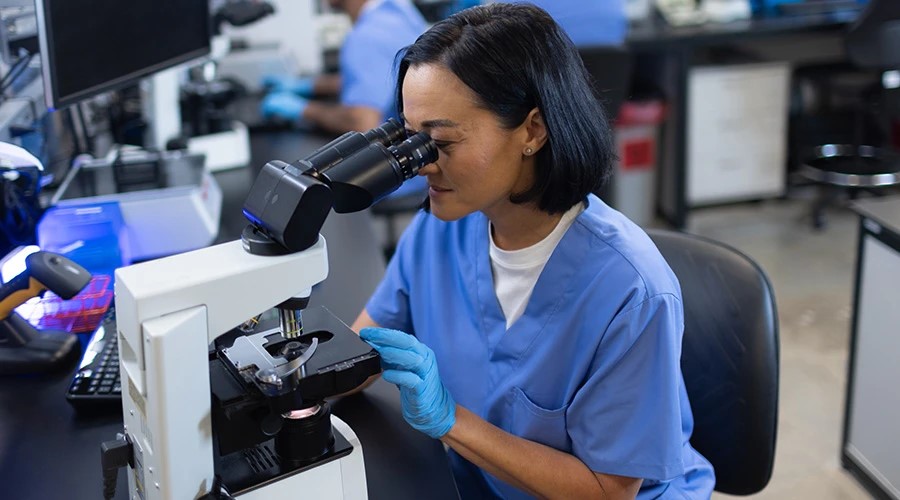Stem cells: your body’s natural repair team
Stem cells are your body’s natural repair team, continuously working to repair and renew tissues. They play a crucial role in maintaining the health of various tissues such as blood, heart, bone, skin, muscles, and brain.1 Stem cells are actively involved in these processes, helping our bodies to recover from damage and maintain their functions over time. Learn more about your baby’s amazing newborn stem cells with these newborn stem cell myths dispelled.
Types of stem cells: pluripotent vs multipotent
Not all stem cells are the same. Pluripotent stem cells can develop into any specialized cell type in the body, offering immense potential for regeneration and repair. In contrast, multipotent stem cells, found in cord blood and adult tissues like bone marrow, can only become certain types of cells. Both types are crucial in research and clinical applications, driving advancements in medical treatments.2 Explore the history of newborn stem cells for more context.
Universal presence: stem cells in all mammals
Stem cells are universally present in all mammalian species, highlighting their fundamental role in biology. This universal presence underscores their evolutionary importance and opens up numerous possibilities for medical research and treatments across different species.3
Medical applications: treating 80+ diseases
Newborn stem cells can be used to treat over 80 diseases, including various cancers, blood disorders, immune system disorders, and metabolic conditions like leukemia, lymphoma, and sickle cell anemia.4 There have been numerous successful treatments and ongoing research efforts leveraging stem cells to improve patient outcomes. Check out the CooperSurgical stem cell sample releases for examples of these advancements.
Cord blood vs. bone marrow: stem cell concentration
Umbilical cord blood has several advantages over bone marrow, including a high concentration of stem cells, less stringent HLA-matching requirements for use in treatments, and an easy, non-invasive collection process. Cord blood continues to be a valuable source of cells for use in transplant medicine.5
Cord Milestone achieved: 1 million+ stem cell transplants
As of 2020, close to 1.5 million hematopoietic cell transplants have been performed using bone marrow, peripheral blood, and cord blood.6 This milestone underscores the profound impact of stem cell transplants on medical practices and patient outcomes, offering hope and treatment for many serious conditions. For example, using a matched donor helps alleviate the risk of graft-versus-host disease (GVHD) by ensuring better compatibility between the donor’s and recipient’s immune systems.7
Future potential: 3D printing with stem cells
Researchers are pioneering the use of stem cells in 3D printing technologies to create skin, bones, and organs. This innovative approach has the potential to revolutionize medicine, offering new ways to treat injuries and diseases by creating custom tissues and organs for patients.8
Did you learn some new facts about stem cells, or were you already a stem cell master?
1. Answers to your questions about Stem Cell Research. (2024). Retrieved from Mayo Clinic: https://www.mayoclinic.org/tests-procedures/bone-marrow-transplant/in-depth/stem-cells/art-20048117 2. Tabansky, I. (2016). Basics of stem cell biology as applied to the brain. Retrieved from NCBI Bookshelf: https://www.ncbi.nlm.nih.gov/books/NBK435799/#:~:text=Stem%20cells%20are%20usually%20categorized,all%20embryonic%20and%20adult%20lineages 3. Chakraborty C, Agoramoorthy G. Stem cells in the light of evolution. Indian J Med Res. 2012;135(6):813-819. 4. Access, C. (n.d.). Cord Blood Myths and Facts. Retrieved from https://www.cb-association.org/myths-and-facts 5. Sanchez-Petitto, G., Rezvani, K., Daher, M., et al. (2023). Umbilical Cord Blood Transplantation: Connecting Its Origin to Its Future. Stem Cells Translational Medicine, 12(2), 55-71. doi:10.1093/stcltm/szac086 6. Tabansky, I. (2016). Basics of stem cell biology as applied to the brain. Retrieved from NCBI Bookshelf: https://www.ncbi.nlm.nih.gov/books/NBK435799/#:~:text=Stem%20cells%20are%20usually%20categorized,all%20embryonic%20and%20adult%20lineages 7. Hamilton, B. K. (2021). Updates in chronic graft-versus-host disease. Hematology American Society of Hematology Education Program, 2021(1), 648-654. 8. Murata, D., Arai, K., & Nakayama, K. (2020). Scaffold-Free Bio-3D Printing Using Spheroids as “Bio-Inks” for Tissue (Re-) Construction and Drug Response Tests. Advanced Healthcare Materials, 9(15), e1901831.

